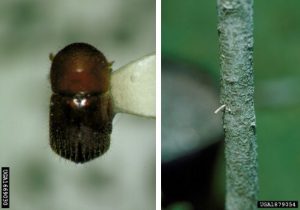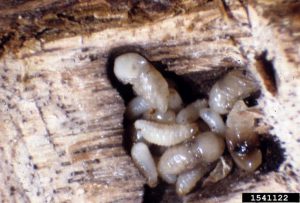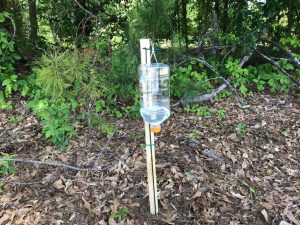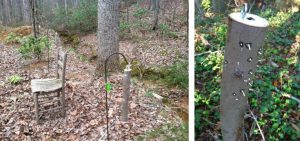Granulate ambrosia beetle (Xylosandrus crassiusculus (Mot.); Fig. 1a) is a serious pest of woody trees and shrubs in Georgia. This was previously known as the Asian ambrosia beetle. These tiny beetles were first detected in South Carolina in the 1970’s and have spread across the southeastern US. Woody ornamental nursery plants and fruit trees are commonly affected. In spring or even in late winter (around mid-February), a large number of beetles can emerge and attack tree species, especially when they are young. Some highly susceptible tree species include Styrax, dogwood, redbud, maple, ornamental flowering cherry, Japanese maple, crapemyrtle, pecan, peach, plum, persimmon, golden rain tree, sweetgum, Shumard oak, Chinese elm, magnolia, fig, Rhododendron and azalea. The female beetles land on the bark of woody trees. Then, they bore through the softwood and vascular tissues (xylem vessels and phloem) of the tree. They settle in the heartwood and begin carving galleries.
Biology
Females of granulate ambrosia beetle commonly attack small trunks of young nursery trees. They drill a network of tunnels within the heartwood where they lay eggs. Similar to other beetles, granulate ambrosia beetle has egg, larval stages, pupae and adults. Except for adults, all other stages occur within the tree trunk. In the galleries, larval stages and pupae can occur together (Fig. 2). Adults introduce symbiotic “ambrosia” fungi into the galleries as a food source for the developing larvae. Adults feed on the same fungi and remain along with their young until they mature and become adults. The female granulate ambrosia beetle is about 2.5 mm long. The young females mate with their male siblings within the galleries. Females can readily fly whereas, the males are flightless; thus, males are rarely found in alcohol traps. Mated females leave the host trees seeking new trees to invade and lay eggs. They attack trees in various physiological states including those stressed by drought, flooding, mechanical wounding and even trees that are apparently healthy. Typically, infestations are found below shoulder height on the tree.
Damage
Symptoms of an active infestation include “toothpicks” or strings of sawdust pushed out of tiny pinholes bored in the bark (Fig. 1b). Severely infested trees with granulate ambrosia beetle may show symptoms of stunting, delayed leaf emergence in spring, and premature defoliation. The toothpicks are delicate and can easily break apart and dissolve with rain. Once young trees are infested with ambrosia beetles in the nursery, they can serve as a breeding site for future infestations. Those infested trees should be removed and destroyed promptly.
Monitoring and management
Once adults of granulate ambrosia beetle bore through the bark, there are limited control options to mitigate the problem. Those beetles protected in the heartwood of the tree are less likely to be exposed to insecticides. The beetles do not consume the wood, which further minimizes their insecticide exposure, even if using systemic products containing neonicotinoid or diamide insecticides.
Pyrethroid insecticides such as permethrin or bifenthrin can be used as preventative sprays to repel invading females. Thus, the insecticide-application timing becomes critically important for management. The insecticide applications can be properly timed with trap captures or adult activity. The simplest method to determine adult activity in the area is using an alcohol based trap (Fig. 3) or a bolt of wood (Fig. 4). A wood bolt (about 2 to 4-inches in diameter and 2-feet long) can be utilized. Any hardwood species such as maple will work for building traps. A half-inch diameter hole drilled at the center of the bolt, about a foot deep, is filled with alcohol and the opening can be closed using a stopper cork. Ethyl alcohol or grain alcohol with 95-percent alcohol content (190-proof) can be found at most liquor stores. Hang several bolt traps along the woodland border of a nursery at waist height to determine beetle emergence and activity. Sawdust toothpicks (Fig. 4) will begin to appear on the bolt of wood when they are infested with adult beetles. Once toothpicks are detected on a bolt trap, daily scouting should occur on nearby trees.
An immediate spray using a pyrethroid insecticide on nursery trees is warranted upon detection of toothpicks on the bolt trap. Be prepared and ready to act quickly as soon as beetle activity is confirmed. If practical, the entire nursery should initially be treated with an area-wide application to repel beetle activity. If individual trees are found to be infested, immediately destroy infested trees and follow up with targeted spray applications in blocks with beetle activity. Insecticide applications will not provide 100% control. Re-application of the insecticide is generally required at frequent intervals until spring green-up is complete in areas where the beetle pressure is moderate to severe. Recent studies show that residual effects of permethrin lasts up to four weeks; whereas, bifenthrin insecticide residues will not consistently reduce ambrosia beetle attack for more than 10 days.
Trees that are otherwise healthy can withstand a low level of beetle infestation. Timely irrigation and adequate fertilization of trees throughout the growing season will increase a tree’s tolerance to beetle infestations. Highly saturated, anaerobic soil conditions can cause tree root stress. If soil media moisture is greater than 50%, it can attract ambrosia beetles; thus, maintaining the soil media moisture level below 50% will help reduce ambrosia beetle attack. Woody trees planted in low-lying areas, which are likely to be flooded with prolonged rain events need to be closely monitored, as the poor drainage can increase the chances of infestation. Closely monitor traps throughout the spring for a second emergence of ambrosia beetles. Ambrosia beetles can have multiple generations throughout the year and are strongly attracted to trees that are drought stressed, waterlogged, injured, or excessively pruned. Pay close attention to irrigation needs during extended summer and fall drought periods to minimize tree stresses. Avoid mechanical wounding of trees with maintenance equipment that could invite ambrosia beetles to attack.
Because of abrupt winter temperature changes in Georgia, it is critical that the monitoring traps be deployed starting the first week of February. The warmer periods during a mild winter may trigger an early beetle emergence and infestation.

Fig. 1 (A) Female of granulate ambrosia beetle (left), (B) “tooth-pick” symptom on trunk as indication of granulate ambrosia beetle attack (right) (Photo left: Steve Passoa Photo right: G. Keith Douce)

Fig. 2 Occurrence of larval and pupae of granulate ambrosia beetle in a tunnel (Photo: Lacy L. Hyche)

Fig. 3 Alcohol trap deployed along wood border (Photo: Shimat V. Joseph)

Fig. 4 Bolt trap deployed along wood border (Photo: https://blog.extension.uga.edu/pecan/2015/01/managing-ambrosia-beetles)